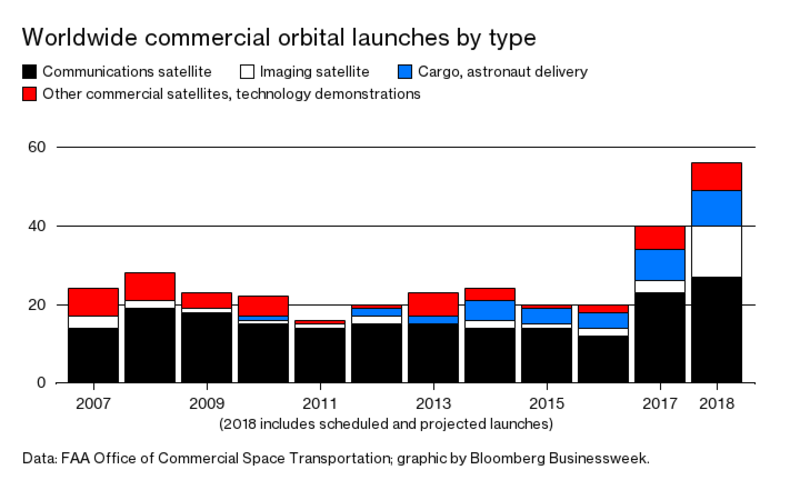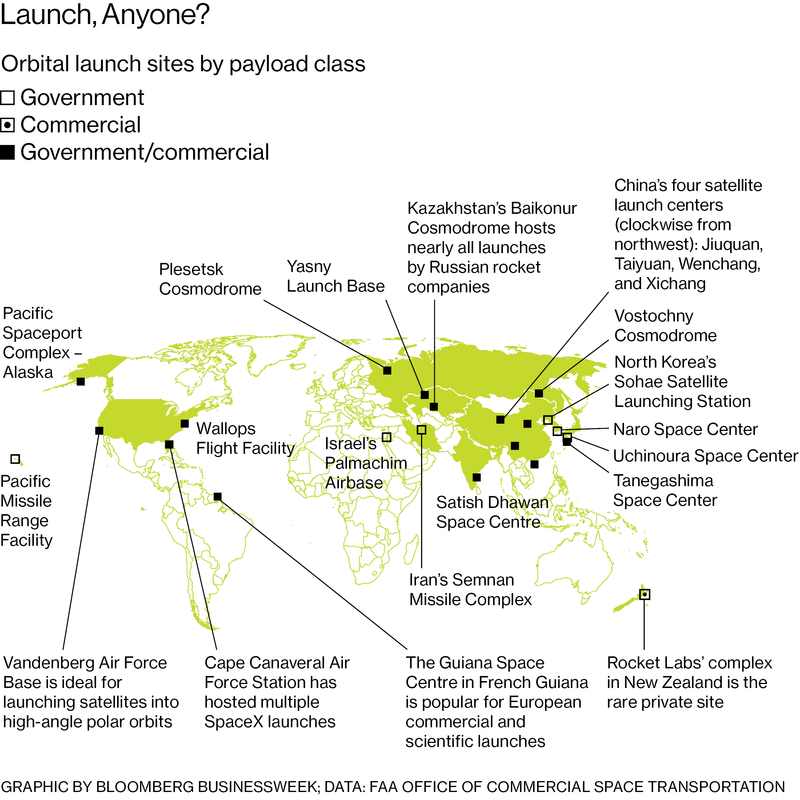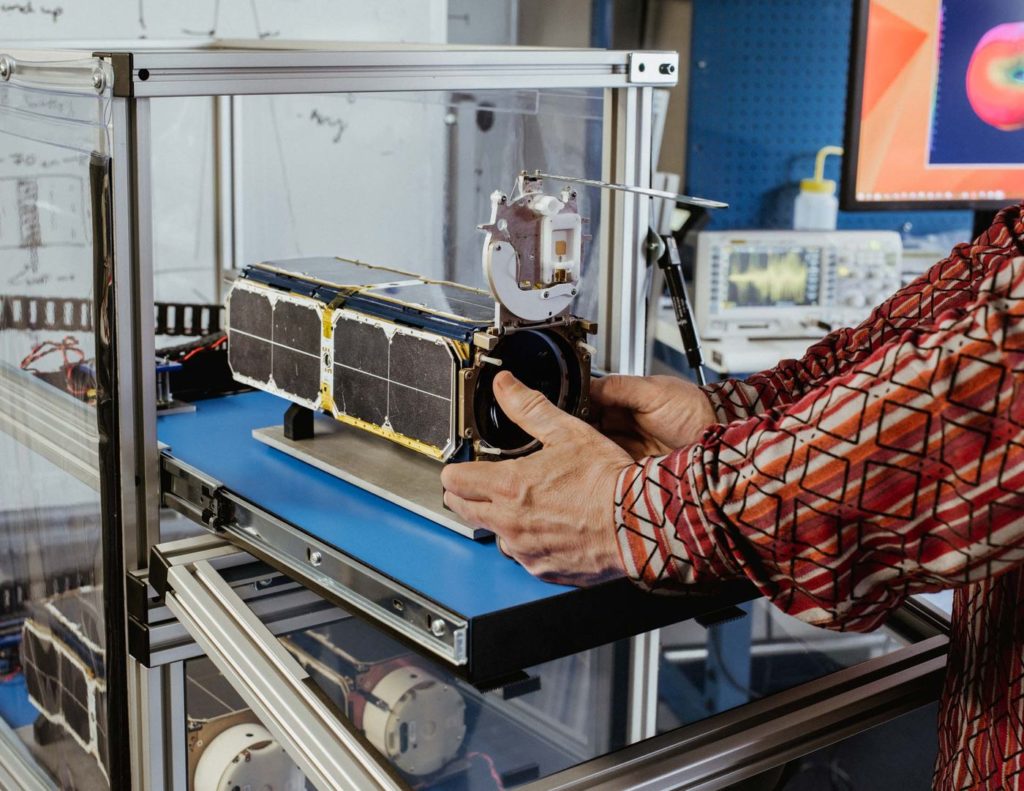The Tiny Satellites Ushering in the New Space Revolution
TECHNOLOGY, SCIENCE, 24 Jul 2017
Ashlee Vance | Bloomberg – TRANSCEND Media Service
Planet Labs and other companies are sending hundreds of low-cost satellites into orbit. We’re only beginning to understand how that will change life on Earth.
29 Jun 2017 – A good rocket launch site has a few important characteristics. An unpopulated patch of land near an ocean is preferable, so no one gets showered with wayward bits of flaming metal. It’s also nice if it’s on the equator—like all spheres rotating on an axis, the Earth spins fastest in the middle, which provides rocket boosters with extra oomph. In other words, the best sites tend to be in remote, tropical locations. That such places are also often among the world’s poorest gives many launches a counterintuitive feel: billions of dollars in futuristic machinery rising up over rainforests and shantytowns.
That was so, at least, this February in Sriharikota, an island off India’s southeast coast, a couple of hours north of Chennai. To reach Sriharikota, which on maps looks like a 17-mile-long snake feasting on a 5-mile-wide goat, you cruise along a chaotic highway where semis vie for right of way with women carrying water buckets on their heads. Eventually you reach a causeway that, during the dry season, is flanked by marshlands, salt ponds, and mud. At the end of this road is the Satish Dhawan Space Centre.
The facility, which opened in 1971 and was named for an Indian rocket scientist, looks more like a defunct disco than a gateway to tomorrow. At the check-in area, splotches of concrete peek through yellow-painted walls where photos of rockets and renowned engineers hang haphazardly. Beneath bulbs dangling from exposed wires, a team of friendly barefoot officials takes your information, then sends you outside to a mango-tree-shaded security gate. The police officers in olive-green uniforms and dark blue berets take no notice of the occasional white cow lumbering through the gate.
From there you reach a central compound of pastel-colored offices and living quarters, surrounded by a jungle of casuarina, eucalyptus, and palm trees. A ways away, at the water’s edge, is the launch pad. More cows collect outside the entry gate, while monkeys chatter in the trees.
At 9:28 a.m. on Feb. 15, these animals watched anxiously as an Indian rocket lifted off, roaring through the hot, sticky air. Its payload consisted of 104 satellites, dwarfing the previous world record of 37 set by Russia in 2014. The largest of them weighed 1,500 pounds and was designed to map India’s infrastructure and monitor urban and rural development. Nestled alongside were around a dozen smaller satellites from universities, startups, and research groups. What made the launch a record were the 88 shoebox-size “Dove” satellites built by Planet Labs Inc., a startup in San Francisco.
For the past few years, Planet has been sending batches of its Doves into orbit, each carrying a high-powered telescope and camera programmed to photograph a different swath of Earth. The 88 launched from Sriharikota would join 61 others to become the largest fleet ever put in orbit. Images beamed back by the 61 have been used far and wide: Hedge funds scour Walmart parking lots to measure traffic flows during back-to-school seasons. Farmers assess crop health and estimate optimal harvest times. Activists track Amazonian deforestation and Syrian refugee camps. Spies monitor military buildups and trafficking operations. With all 149 satellites in place, Planet will be able to photograph every inch of Earth’s surface every day—something even the U.S. government can’t do.
This satellite constellation is one of many signs that the relationship between humans and space is changing in ways unseen since Russia and the U.S. began sending rockets into orbit six decades ago. Thanks to modern software, artificial intelligence, advances in electronics and materials, and a generation of aggressive, unconventional entrepreneurs, we are awash in space startups. These companies envision an era in which rockets take off daily, filling the skies with satellites that sense Earth’s every action—in effect building a computational shell around our planet. The people constructing this bustling new economic highway promise it will improve life down below, but the future they describe is packed with wonder and controversy in equal measure—and although few have noticed, it’s coming to pass right now.
The New Space revolution’s satellite boom began near another marshland, two oceans away from Sriharikota, where the San Francisco Bay meets the border of Mountain View, Calif. There you’ll find the NASA Ames Research Center, marked by odd-shaped buildings and some hangars that once housed Depression-era airships and enormous old wind tunnels.
Since 2006, under the stewardship of Pete Worden, Ames has garnered a reputation for far-flung experimentation. Worden, an astrophysicist and former U.S. Air Force brigadier general, spent decades running Black Ops missions and oversaw the development of Ronald Reagan’s never-built Star Wars missile defense shield, among other jobs geared toward weaponizing space. At Ames he delighted in hiring adventurous young engineers for unusual research projects and forged strong ties with Silicon Valley, inviting startups to set up on NASA property and creating commercial links between the organization and Google Inc. He was also eccentric, occasionally donning a robe and taking to the surrounding fields with a staff to herd goats.
Among Worden’s first hires were a pair of rabble-rousing engineers named Will Marshall and Robbie Schingler. The three men had met a few years earlier at a space conference in Houston, where Marshall and Schingler were handing out fliers decrying a renewed push under George W. Bush to militarize space. “I was having a drink with a colleague in a bar and could hear this guy with a loud British accent pushing against space weapons,” Worden says of Marshall. “I said, ‘Do they know Darth Vader is sitting right here?’ ” He called the men over for a drink and an argument, and the three of them hit it off.
Marshall, who has a doctorate in physics from the University of Oxford, worked on a number of teams at Ames, including ones building a cheap lunar lander and the LCROSS (Lunar Crater Observation and Sensing Satellite) probe, which found water at the moon’s south pole. Schingler focused on making satellites for scientific missions, including one to find exoplanets, and on making NASA technology and data more accessible to the public.
Toward 2009, Ames researchers started batting around the possibilities opened up by smartphones. The first iPhone had been released two years earlier, and the scientists were awed that devices so small could pack so much horsepower and such sophisticated sensors and imaging technology. Could smartphones be the template for a new kind of satellite, they wondered?
Typical satellites are about the size of a bus. They take years to design and build, weigh maybe 7,000 pounds, cost as much as $300 million, and rely on specialized electronics that can withstand conditions anywhere from 100 miles to 22,000 miles above Earth. They’re technological marvels and yet so time-consuming to make and launch that they often run on antiquated computing systems for the decade or more they’re in use.
Convinced of the potential for improvement, the Ames scientists, led at first by Marshall and a young Australian physicist named Chris Boshuizen, and soon by Schingler as well, set to work on a version of a CubeSat, a satellite that can fit into a very small case. The device they hoped to build would be inexpensive and light, capable of being constructed quickly and deployed en masse to perform independent or synchronized tasks. If space radiation fried a component now and again, no problem—the satellites would be so cheap as to verge on disposable.

A rocket carries 104 satellites to orbit from Satish Dhawan Space Centre, Feb. 15.
Photographer: Sanjit Das for Bloomberg Businessweek
Boshuizen and Marshall assembled their first CubeSats by hand, ripping apart an HTC Nexus One and connecting antennas, a large battery pack, and other electronics to the smartphone’s innards. Within a few months, they had a prototype performing well in NASA’s labs; a couple of months after that it successfully delivered data to Earth from a high-altitude balloon.
At the time, Marshall and Schingler were living together in nearby Cupertino in a seven-bedroom, 5,000-square-foot group house called the Rainbow Mansion. Schingler and his girlfriend had set up the place for engineers and assorted idealists to live communally, holding salons by the koi pond at which they discussed the world’s problems. After Marshall and Boshuizen told Schingler about their work on the satellites, the house also became a research and development laboratory. As the three tested ideas in the garage at night and on weekends, they became convinced they had the basis for a new company. They initially decided to call it Cosmogia Inc.—“a nod to cosmos with some arbitrary ending,” Marshall says.
The idea behind the venture was to launch dozens, if not hundreds, of CubeSats, which would form a kind of line scanner for the Earth. Each satellite would be deployed in a unique position from which it could continuously photograph a swath of the planet. Anyone who’s used Google Earth will get the concept. But whereas Google’s images are often months or years old, Cosmogia’s would be compiled daily into a database that allowed users to see recent images and compare their evolution over time.
The founders saw the database they would create, and the radical transparency that it entailed, as a public good, freely available to nonprofits combating deforestation and environmentalists monitoring polar ice cap melting. They imagined that a daily accounting of the Earth would prompt its denizens to steward it more responsibly. And, of course, along the way they could make heaps of money selling images to hedge funds, farmers, and spies.
Armed with this pitch, a few prototypes, and Worden’s blessing, Boshuizen, Marshall, and Schingler left Ames toward the end of 2010. They packed up their lab at the Rainbow Mansion lab and departed for a dodgy, crack-stricken neighborhood in San Francisco, where they founded a new company called Planet Labs.
At first, many in the aerospace industry considered Planet Labs’ satellites a gimmick—too small to produce useful high-resolution images and too complex to manage by the dozen. Moreover, neither Marshall, the chief executive officer, nor Schingler, the chief strategy officer, with their hardcore engineering backgrounds and granola-fortified philosophies, came off as budding titans of commerce. (Boshuizen, the chief technology officer, left the company in 2015.)
Marshall, who’s 38, grew up a space-fascinated child in a middle-class home in Kent, south of London. As a teenager, he worked at a pub and as an electrician—“I would electrocute myself quite often, because I’d gotten too drunk the night before,” he says—to raise money to build his own telescope. At Oxford, he studied some outré corridors of physics, such as quantum teleportation and quantum superposition, and seemed destined for an academic career. But he kept coming back to his original calling, completing a series of internships at American space research centers and becoming a vocal leader among a generation of engineers eager to try new aerospace ideas.
Marshall is rail-thin, pale, and bookish, but he’s far more adventurous than he appears. For years he traveled to remote parts of Africa to teach science to schoolchildren. In the U.K. he sometimes broke into hard-to-reach places for kicks—including, once, Windsor Castle while the Queen was there. He’s also direct and outspoken, so much so that after he arrived at NASA, an irritated member of his lunar lander team instigated a federal investigation into whether he was a spy. The investigation carried on for years; at one point immigration officials detained Marshall at San Francisco International Airport and confiscated his computing equipment. “It was scary as shit,” he says. “I was worried about it f—ing up the projects that we wanted to do.” Nothing came of it in the end.
Kevin Parkin, a childhood friend who also worked at Ames, describes Marshall as having an aura of kismet about him. “Will has what I can only describe as a reality field that attracts VIPs,” Parkin says. He recalls Marshall deciding one time to hike through nearly 20 miles of wilderness from the Rainbow Mansion to the sea: “Will walked off into the hills without so much as a bottle of water and returned the next day in a car driven by Larry Page and Sergey Brin, whom he had randomly met at the beach.”
Schingler, also 38, is just as unconventional. While in India for the 88-satellite launch, he crashed on couches, spending one night sleeping next to an ice cream machine on the concrete floor of a shed. He also visited a local temple to pray and bought 88 golden Ganesh figurines for good luck. Schingler and his wife have set up a series of communal homes around the world—part of an unending experiment to question societal structures. He, Marshall, and some other friends recently entered into a pact stipulating that should any of them come into a windfall, large purchases must be approved by vote, and the bulk of the money must go toward some greater good. “There are many people that feel way more alienated when they become wealthy,” Schingler says. “Rather than become estranged from family and friends, I’d rather be surrounded by people and projects aligned by a theory of change.”
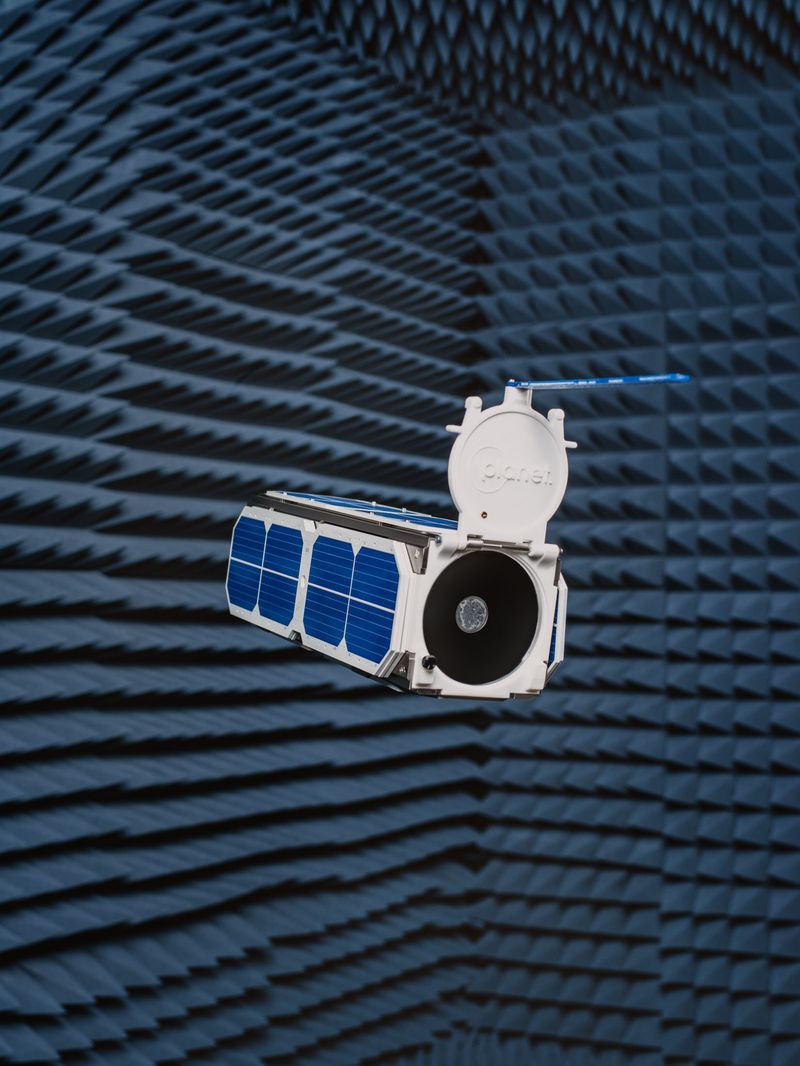
A shoebox-size Dove satellite from Planet Labs.
Photographer: Justin Kaneps for Bloomberg Businessweek
Planet Labs may soon bring the pact into force. Seven years after being founded, the company is on the 14th iteration of its Doves and can knock out 20 of them per week from a small factory inside its headquarters. Each of the satellites is a black, lightweight aluminum cuboid measuring 10 centimeters by 10 centimeters by 30 centimeters and containing 2,013 components. Inside is a cylindrical telescope wrapped in gold-plated tape to provide thermal insulation and surrounded by six lithium ion batteries, individual heaters for each one, and a handful of circuit boards. Planet won’t say how much a Dove costs to make, but a person familiar with the company’s operations says it’s well into the six figures.
To reduce risk, most satellite makers try not to fiddle with their designs. Doves, by contrast, can constantly evolve, because Planet’s testing and manufacturing routines allow engineers to certify processors and image sensors for flight within days. Over the past few years, the company has sent 233 satellites into space on a mix of American, Indian, Japanese, and Russian rockets. On two occasions the rockets have blown up, scattering Dove chunks across coastlines. These were expensive losses, but Planet has built such failures into its business model. If a rocket explodes, the company can simply order its employees back to the factory and start negotiating the next ride. As it is, the satellites are built to last only about three years, after which they fall back to Earth, disintegrating in the atmosphere.
For multi-Dove launches, such as the Indian one in February, the rocket gets into position, then tips forward and slowly rotates, releasing a Dove or two every couple of degrees at a speed of about 1 meter per second. Dozens can be launched this way in about five minutes. Once a Dove has been released, its solar panels unfurl, a lid at one of its ends pops open, and an antenna extends. The satellites come out of the factory black, but Planet likes to add artistic splashes with white paint—in footage shot from the Indian rocket, the Doves look like a string of white pearls spreading out against the backdrop of space.
To get the satellites into optimal position, Planet uses a technique called differential drag, in which the solar panels act like sails pushing against the trace of atmosphere available to slow a chosen Dove down with respect to the others. Turned forward, the panels produce seven times as much resistance as when they’re horizontal. The concept had been largely theoretical until Planet proved it could be done for an array of satellites.
When the Doves have been launched into a sun-synchronous orbit (one crossing the equator at the same local time every day), algorithms adjust their panels to guide them into position, spacing them out evenly. Getting all 88 of the Indian-launched satellites to fan out properly took a few months. As this story goes to press, they’re coming into perfect position.
Once aligned, Planet’s attitude and determination control system, which sets the satellite’s orientation, takes over. Gyroscopes and sensors on the Dove look for magnetic fields and seek out the Earth’s horizon, the sun, and other stars. Magnetorquers and reaction wheels then adjust the satellite’s movement until it reaches the desired alignment. “It’s not that difficult to make a system that does this,” says Ben Howard, Planet’s chief spacecraft architect. “It’s difficult to make it as cheaply as we have and to make it tuned so well for a specific application.”
Each Dove is responsible for collecting 10,000 images covering 2 million square kilometers per day, an area the size of Mexico. The pictures—40 gigabytes’ worth—are relayed during 10 daily eight-minute sessions on custom-built radios between the satellites and a dozen ground stations built by Planet in Antarctica, Chile, Hawaii, Iceland, and other places.
Once the images reach Earth, Planet’s software compiles them, cleans them up, and deletes photos marred by clouds and shadows. Customers can then log on to an application and browse the pictures as they please. Planet’s largest clients include the Mexican government, the German space agency, and the agricultural companies Monsanto, Wilbur-Ellis, and Bayer Crop Science. They pay millions or even tens of millions of dollars per year for access to the most recent, highest-quality images. Nonprofits, students, and news organizations receive the same access for free, while the public at large can see older, lower-quality pictures gratis. Planet refuses to say how much revenue it draws, but it appears to be enough to keep investors interested. The company has raised more than $180 million in venture capital to date, and its valuation has been widely reported to exceed $1 billion.
Planet’s 88 new satellites, which will give it the only daily view of Earth, at least for now, promise to be even better for the bottom line. “Businesses, governments, scientists, and society as a whole have never had this pulse of the planet before,” Schingler says. “The world is changing as rivers shift, agricultural productivity shifts, and towns and forests shift. This data is going to be activated for all these users and open up a novel vantage point that actually gets used in our daily decision-making.”
In mid-April the National Geospatial-Intelligence Agency, which analyzes images for the Department of Defense and U.S. intelligence services, held a conference in Springfield, Va., to discuss how the sudden flood of satellite photography was changing espionage. The crowd of NGA image analysts, Planet Labs customers, and others relinquished their electronic devices in secure lockers, then gathered in a large wood-paneled auditorium.
In the 1960s the satellite images the government needed were extremely hard to obtain. The U.S. had a program called Corona, in which an imaging satellite would take pictures and physically eject a capsule full of film toward Earth. A plane outfitted with a net would then try to catch the capsule midair. Amazingly, this system worked often enough to be useful.
The process is much simpler today, but truly high-quality images remain a rare commodity. The market leader is DigitalGlobe in Westminster, Colo., which operates a network of large satellites that produce “exquisite” pictures, in industry parlance. Their resolution is top-notch, capable of rendering objects as small as cars. The company says it can scan 60 percent of the Earth every month and capture specific targets on request. (The U.S. government usually gets priority.) DigitalGlobe’s satellites orbit at about 370 to 500 miles above Earth, higher than Planet Labs’ 230 to 310. In Planet Labs’ photos, while you can still make out cars, it’s hard to tell what color they are, for example.
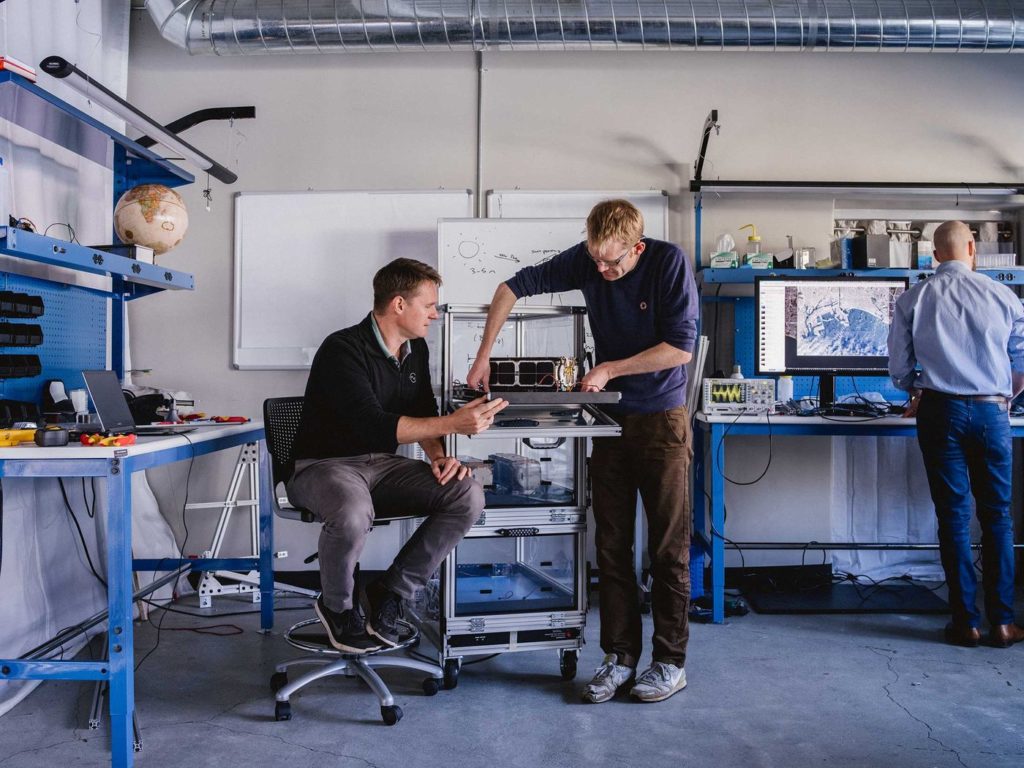
Schingler and Marshall at work in Planet’s San Francisco office.
Photographer: Justin Kaneps for Bloomberg Businessweek
To deal with the avalanche of new satellite imagery, companies are creating software that performs initial photo scans for movements and anomalies, then flags these for analysts. The shift toward artificial intelligence has many in the NGA feeling uneasy about their job security, but Robert Cardillo, the agency’s director, says the move from monopoly control over images to open competition has been exciting: “We’re lowering the cost to space, and we’re lowering the cost to participate once you get there.” Last year the NGA signed a $20 million deal for seven months’ worth of unfettered access to Planet’s images. “I want the anxious to scoot to the edge of their seats. Get involved and engaged,” Cardillo says.
Some are already there. Gerby Marks, a counterterrorism expert and former DigitalGlobe employee, was considering retiring from the field when Planet came along. The combination of daily images and AI seemed to her a revelation—a way to predict the future rather than react to the past. “DigitalGlobe will only start looking at a site once there is a request to be tasked to it,” she says. “Now we’re able to detect things before we even know about them.”
In a presentation at the conference in Virginia, Marks showed work done by her consulting company, 3 Gimbals LLC, with the U.S. Southern Command. Her team had gathered a couple of days’ worth of Planet images from Puerto Cabello, on Venezuela’s northern coast, and analyzed them with an algorithm designed to monitor shipping traffic. When the software detected increased activity at a particular pier, Marks and her team cross-searched the pier’s geolocation coordinates online. That led them to photos posted on VK, a Russian social network.
Her analysts couldn’t be sure without doing fieldwork to verify, but it appeared as if the vessels at the pier were Russian and that the crews had been boasting online about their travels. “Now you can look at the boat to see what type of equipment it has,” Marks says. “You can see if it seems to be linked to a certain commodity or industry. You can find trends of what is normal and what’s anomalous activity.” She adds: “You have to have images taken more than once a month to understand and interpret change.”
The term of art for the material analysts seek is “patterns of life.” It refers to the study of how people and objects move, which in turn allows an observer to form a story about what might be going on. Can she, for example, catch a virus outbreak early by spotting unusually high commuter traffic flows to hospitals? Silicon Valley types have naturally flocked to the life-pattern concept and, armed with the images and algorithms, begun doing things that could either inspire or horrify the public.
At the NGA conference these entrepreneurs included James Crawford, who once oversaw Google Books, that company’s effort to make millions of volumes searchable online. Crawford is now the CEO of Orbital Insight, a startup in Mountain View. Orbital Insight takes images from Planet, DigitalGlobe, and public repositories and combines them into a unified database. Its algorithms then begin searching for objects such as cars, buildings, trees, oil tanks, solar panels, rail cars, ships, and airplanes. The algorithms improve as they go, such that in a matter of days they can identify objects all over the world, even as the terrain and surrounding infrastructure change.
Crawford can call up an image of a port in Shanghai that’s been broken down like a puzzle, with cylindrical oil storage tanks color-coded green, ships in red, and buildings in blue. Hit a button, and the software shows that eight new buildings have gone up in a few months. Hit another button, and the software will calculate how much oil is in a given tank. “There are floating lids that sit on top of the tanks,” Crawford says. “If the lid is all the way up, there’s no shadow, and we know it’s full.” If there’s a shadow, Orbital Insight measures its angle and the dimensions of the tank to calculate the volume of liquid inside.
What Crawford’s company is after, he says, is “observational truth.” Orbital Insight takes analyst and government reports on, say, how much oil is said to be in China and compares its calculations with those of experts, who it turns out are often wrong. For example, the rough industry consensus last year was that China had approximately 400 million barrels of oil in reserve. But Orbital’s own figure was 550 million. It found there were 2,100 oil tanks capable of holding 1.1 billion barrels of oil, and they were half full on average.
Another startup, SpaceKnow Inc., delivers similarly detailed information via a web service that’s dead simple to use. Want to know what Russia is up to in Crimea, the territory it annexed from Ukraine in 2014? Highlight the region on a map, and SpaceKnow will return a play-by-play showing photographic evidence of the Russian army dredging parts of the Black Sea, then building bridges and roads to prepare for the arrival of more troops and tanks. “You can see that they’re trying to connect the southern part of Crimea to the main part of Russia so they can invade it more easily,” says SpaceKnow CEO Pavel Machalek.
The company also estimates the gross domestic product of countries in Africa by counting the number of lights on at night, monitors the movement of every boat in the ocean, and tracks the amount of coal coming out of mines. “You would need 1,000 human analysts to do any of these things,” Machalek says. “But the machine—the algorithm—never gets tired.”
Those concerned about the privacy implications of all this can perhaps take some comfort in knowing that Planet and DigitalGlobe’s satellites can’t see people’s faces or the license plates on their cars. The technology is better suited to identifying patterns of life in industry and the environment. Still, Planet has created a Google-style search engine for Earth, capable of looking down on humans and spitting back answers about their day-to-day activities within minutes. It’s unclear how the spread of such images, at almost military-grade quality, will affect global security and other realms, and whether the trade-offs will be worth it.
Marshall and Schingler, who did a great deal to bring all this about, don’t dodge ethical questions, although their answers can be unsatisfying. Planet urges customers not to use their images for combat operations, for example, but has no real means to prevent this. “In general, I’m OK with the intelligence side,” Marshall says. “Historically, like during the Cold War, transparency has led to reduced tensions.” With respect to the growing problem of space debris, he points out that it owes mostly to the breakup of large satellites in high orbits, and that Planet’s lower-orbit devices are designed to be short-lived.
On the whole, he contends that the good of the technology far outweighs the bad. “If you look at things like disaster response, protecting habitats and protecting our oceans, we can help substantially and in a global way,” he says. “The value to human advancement is tremendous. I would not be here doing this, and nor would many of the people in our company, if it wasn’t for the fact that the net good overwhelms the bad in a huge way.”
Planet Labs has been content so far to sell its images and let others build analytical software that makes the pictures useful. Recently, though, it has begun hiring software engineers to work on its own image analysis system. The goal is to let Orbital Insight and other companies handle specialized jobs for wealthy clients while Planet helps everyone else query its database as they would Google. Not only will this help the public more efficiently perform tasks such as monitoring deforestation, it will allow smaller businesses to improve their services. “I think that sort of thing is doable within a year or two,” Marshall says.
Earlier this year, Planet bought Terra Bella, a maker of larger satellites that produce higher-resolution photos. Terra Bella, which used to be called Skybox Imaging, was once thought more likely than Planet to succeed—a perspective that only deepened when Google spent $500 million to buy it in 2014. Now, Planet has both companies in the fold: When Planet bought Terra Bella, Google took a stake in—and agreed to buy images from—Planet. Owning Terra Bella and its seven orbiting satellites will allow Planet to compete more directly with DigitalGlobe—as well as a flood of new entrants to the game.
The upstarts are working with some technology that’s almost magical. Capella Space Inc. in Palo Alto is developing satellites that rely on synthetic aperture radar, or SAR, which can peer through clouds, produce images at night, and take intricate measurements such as soil moisture levels. Like Planet, it’s been building satellites that are smaller and cheaper than the norm; it plans to send 36 into orbit starting this year. (Planet is also working on SAR satellites in a secret lab.)
SpacePharma, an Israeli company, has built a functioning scientific laboratory that can fit inside a CubeSat. Past research has shown that the lack of gravity in space causes genes to express themselves more strongly than on Earth, and molecules to behave differently as well. There are already examples of plants, medicines, and chemicals being cultivated in space, and the hope is that such research will lead to breakthroughs that can be applied on Earth.
Perhaps the most ambitious of the new companies is OneWeb in Florida, which wants to surround the planet with hundreds, possibly thousands, of small, low-orbit communications satellites. These will form a network accessible to the 3 billion people on Earth who lack high-speed internet service because of geographic and economic constraints. OneWeb plans to begin launching batches of satellites in 2018 on rockets from Virgin Orbit and others. And those are just to name a few: Companies such as Astro Digital, Axelspace, Hera Systems, Iceeye, and Spire have their own imaging satellites, too.
To be sustainable, this satellite boom will require an attendant breakthrough in rocketry. Elon Musk’s Space Exploration Technologies Corp., or SpaceX, was the first to show that one might be possible, inspiring rocket and satellite startups alike by lowering the cost of getting into orbit and proving that private space companies could be viable. There are now about 10 companies making small, cheap rockets that are purpose-built to carry CubeSats.
For now, the one with the most funding and customers is Rocket Lab, which in May completed the first successful test flight of its carbon fiber Electron model from its private spaceport in New Zealand. The company will be charging $5 million per flight once it’s fully operational, far lower than SpaceX’s $60 million, the current industry benchmark. Rocket Lab hopes within a few years to be launching about 100 times annually—the same number conducted in 2016 by the entire aerospace industry. Other companies, such as Vector Space Systems in Tucson and Richard Branson’s Virgin Orbit, are rushing to market with similar rockets and launch-frequency aspirations.
All these new options will give Planet more control over the timing and destination of its launches. Until now, its satellites have tended to be secondary additions to large payloads, as they were in India. The company has already begun forging the relationships it needs and will have satellites on board Rocket Lab’s next two tests and its first three commercial flights. “Launch is the largest barrier to innovation in space today,” Schingler says. “That all of a sudden changes entirely if you have frequent, low-cost, reliable access to space. So the small launchers will be a game changer. There will be new missions that were inconceivable before, and five years from now we will be seeing some amazing things.”
In 2015 venture capital companies pumped $1.8 billion into space startups, almost doubling the combined amount of money invested in the 15 years before. Much of this boom is taking place in the U.S., which has, because of the New Space movement, gone in the span of a few years from retiring the space shuttle and losing its competitive position in commercial launches to reasserting its position as global leader. Russia, the European Union, Japan, China, and India must now decide whether and how much to fund reusable rockets, smaller launchers, and other innovative approaches; meanwhile, companies such as Rocket Lab could allow many other countries to fire up their own space programs.
For New Space’s true believers, the competition will be part of one glorious show: the ultimate expression of humankind’s manifest destiny. “You’ll have the space economy integrating with the terrestrial economy like it never did before,” says Steve Jurvetson, a venture capitalist invested in Planet Labs. “That will cause a bloom of activity, which will make the path to Mars and colonizing other worlds that much more believable and affordable. When that happens, which is, like, within our lifetime, it’ll be one of the watershed moments of humanity. I mean, this is up there like the discovery of fire or evolution’s greatest hits. It’s the point when we become a multiplanetary species.”
Go to Original – bloomberg.com
DISCLAIMER: The statements, views and opinions expressed in pieces republished here are solely those of the authors and do not necessarily represent those of TMS. In accordance with title 17 U.S.C. section 107, this material is distributed without profit to those who have expressed a prior interest in receiving the included information for research and educational purposes. TMS has no affiliation whatsoever with the originator of this article nor is TMS endorsed or sponsored by the originator. “GO TO ORIGINAL” links are provided as a convenience to our readers and allow for verification of authenticity. However, as originating pages are often updated by their originating host sites, the versions posted may not match the versions our readers view when clicking the “GO TO ORIGINAL” links. This site contains copyrighted material the use of which has not always been specifically authorized by the copyright owner. We are making such material available in our efforts to advance understanding of environmental, political, human rights, economic, democracy, scientific, and social justice issues, etc. We believe this constitutes a ‘fair use’ of any such copyrighted material as provided for in section 107 of the US Copyright Law. In accordance with Title 17 U.S.C. Section 107, the material on this site is distributed without profit to those who have expressed a prior interest in receiving the included information for research and educational purposes. For more information go to: http://www.law.cornell.edu/uscode/17/107.shtml. If you wish to use copyrighted material from this site for purposes of your own that go beyond ‘fair use’, you must obtain permission from the copyright owner.
Read more
Click here to go to the current weekly digest or pick another article:
TECHNOLOGY:
- Software Developers in Oakland Are Putting People Over Profit
- Weaponizing Reality: The Dawn of Neurowarfare
- Israeli Intelligence to Be Granted Full Access to National Biometric Database
SCIENCE:
